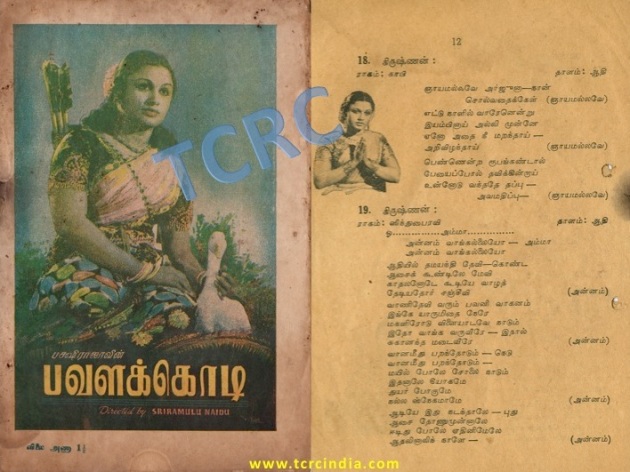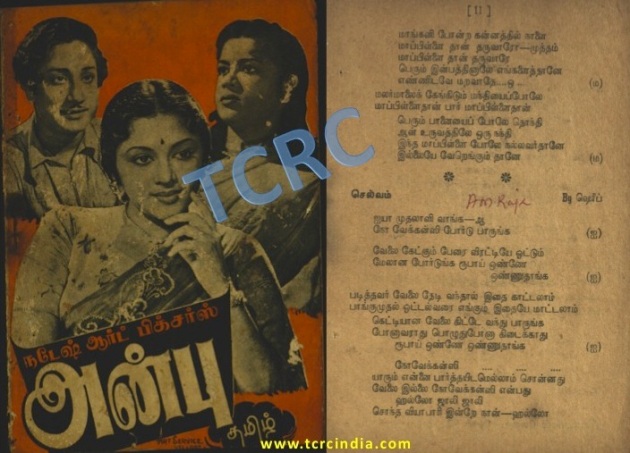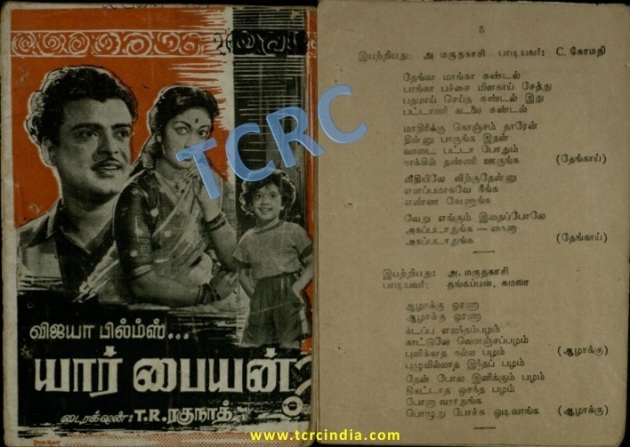By P.V. Gopalakrishnan
Roadside vendors, particularly those shouting out their signature calls to attract customers is a common sight in our towns & cities, though in some of the Metros this is decreasingly seen in this era of Mega Consumerism & Malls.
Our Films never failed to capture such vendors, even including a bit of music on their lips, as the characters happily musically vended their ware. Even big heroes & heroines of those times have had to carry such roles as vendors in some sequence or other, contrived by the directors.
Here we are seeing some instances of the cinematic vendors as they were featured in various films, chronologically.
The rare song ‘Annam vangaleeyo’ rendered by T.R.Mahalingam featured in ‘Pavalakodi’ (1949), composed by C.R.Subbaraman, where TRM was seen hawking a live Swan. Thank god, perhaps, the Wildlife Act was not in vogue those times!

Song book of Pavalakodi with the page containing the song ANNAM VANGALEEYO PC: From the archives of TCRC
A doorstep milk vendor used to be a common sight till a decade or two ago in our lives. Here is a girl hawking cow’s milk with a song, ‘Pasumpal’ The singer was P.A.Periyanayaki from the film Singari (1951), in the music of T.K.Kalyanam. Periyanayaki was a much sought after singer even prior to MLV’s stint as a play back singer on Tamil screen.
There was a song ‘Ayya mudalali vanga’ sung by A.M.Raja for Sivaji Ganesan in the movie Anbu (1953) in the composition of Veteran T.R.Paappa. It is strangely novel that a young man becomes self-employed by selling ‘No Vacancy’ boards in times of acute job losses.

Song book of Anbu with the page containing the song AYYA MUDALALI VANGA PC: From the archives of TCRC
Here is Gemini Ganesan pranking around dancing & singing as he sells flowers to the folks around with the song ‘Ayy ammadi namma arakku pachai’ from the film ‘Athisaya Thirudan’ (1958). The singer was TMS & the Music Director was S.Dakshinamurthy.
Another flower seller, this time by a blind female character enacted by Sriranjani in Gemini produced film ‘Raji En Kanmani’ (1954). The song is ‘Malligai poo jathi malli Roja’ rendered by R.Balasaraswathi Devi in the music composition of S.Hanumantha Rao, brother of the noted Film Composer S. Rajeswara Rao.
Jose Sancho Padilla’s haunting Western number “La Violetera” has largely inspired the song. To enable you to listen & compare with the original tune, a piece from the original is also being featured in between the subject song. The talented Master Dhanraj and R. Parthasarathi, who were part of the ‘Gemini Music Troupe’ at that time under Hanumantha Rao created this classic with western interludes, as inspired by “La Violetera”. The well-known Master Dhanraj was the guitar & piano guru to various celebrity music directors such as Ilayaraja, A.R.Rahman & Vidyasagar, in his music school at Luz corner, located above the landmark Nehru News Mart, in those days.
As to the singer R. Balasaraswathi, she was a child prodigy having started recording for HMV at her six & she was the first playback singer of Telugu cinema too. She had also acted in Tamil films Baktha Kuchela (1936), Balayogini (1937), Tukaram (1938), Thiruneelakantar (1939) etc. After her marriage with the Raja of Kolanka, she gradually faded out in her screen career & went into oblivion.
A seller of tantric talisman? Yes, here he is, singing, ‘Thayathu’. Catch MGR in the ghost voice of TMS in the film ‘Mahadevi’ (1955) in the music of MSV-TKR.
In the bygone days of old Madras, there used to be candy sellers on the streets hawking elongated candy strings as wound on a pole. Here is K.R.Ramaswami singing & enacting the song ‘Jilu jiluvena jolikkum mittai’ from the film Neethipathi (1955). MSV-TKR composed he music.
‘Elanthai pazham’ was made famous by a song of L.R.easwari in her song on that humble fruit, picturised on Vijaya Nirmala in ‘Panama Pasama’. But here we are bringing an older song ‘Aazhakku oar ana’ sung by Thankappan & Kamala in the film ‘Yaar Paiyan’ (1957) in the music of S.Dakshinamurthy.

Song book of Yaar Paiyan with the page containing the song AAZHAKKU OAR ANA PC: From the archives of TCRC
Navrathri Kolu Festival used to have a major seasonal market for colourfully painted clay figures in South India. Besides, they had a market in Temple festivals. There was a sequence where Anjali Devi sold these clay Dolls with P.Suseela rendered song ‘Jorana bommai parunga’ in the film ‘Manalane mangaiyin Bakkiyam’ (1957) as composed by Adhi Narayana Rao.
In the good old film Samaya Sanjeevi (1957), J.P.Chandrababu rendered the song ‘Paper Paper’ composed by the doyen G.Ramanathan, in a sequence selling local newspapers & magazines. An interesting song, which enlists all the magazines, those were popular then.
We are familiar with Sirgazhi Govindarajan’s voice being associated with songs of divinity, philosophical or even comical flavors. But he has sung rarely for a tea seller, enacted by K.A.Thangavelu in Sridhar’s film ‘Kalyana Parisu’ (1959) composed by A.M.Raja.
Baloon sellers are a common place anywhere in the world. You could spot them even at venues such as Disneyworld! Here is a local balloon seller with a song on his lips, ‘Paisavai pottu naisaka vaangi’ filmed on V.K.Ramasami, who has several messages to deliver in the song. The film was ‘Alli Petra Pillai’ (1959) & the singer was S.C.Krishnan for Music Director K.V.Mahadevan.
Bangle sellers were traditionally allowed to catch hold of any woman in their selling effort of bangles. Catch MGR in his funny make over as a fat bangle seller singing ‘Kalyana ponnu’ in the voice of TMS in the film ‘Padagotti’ (1964) in the lilting music of MSV-TKR.
The vast beaches of old Madras city first what was called ‘High Court Beach’ (then turned into part of Madras Port, reaching upto War Memorial) & the Marina used to be sprinkled with humble ‘Sundal’ sellers. Here is a song dedicated to one such, in the song ‘Thenga manga sundal’ of TMS in the ‘Neeyum Naanum’ (1968). The Music was of MSV.
Before we wind up, I would like to cite a vendor’s song from a Hindi movie too. This time, it’s a ‘malishwallah’ offering oil massage services. Listen to ‘Tel Malish’ rendered joyfully by the veteran Mohd.Rafi in ‘Pyassa’ (1957) as composed by S.D.Burman. It is picturised on the late comedian Johnny Walker.
The street vendors are still omnipresent in India, despite the paradigm shift in the way people shop. May be the coming generations miss out on them as they become slowly irrelevant & disappear gradually. But their recognition on our screens of the past is indelible!



